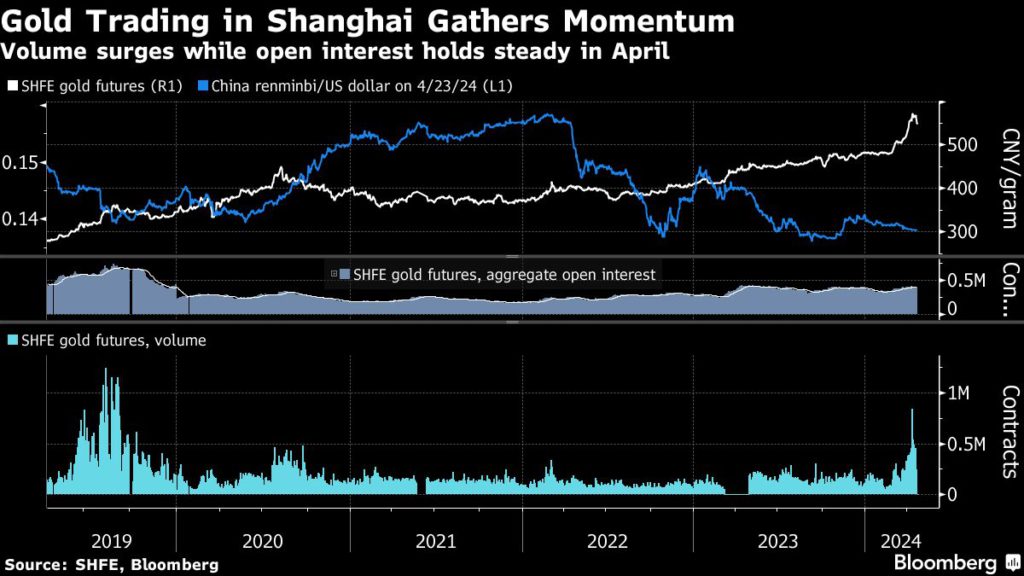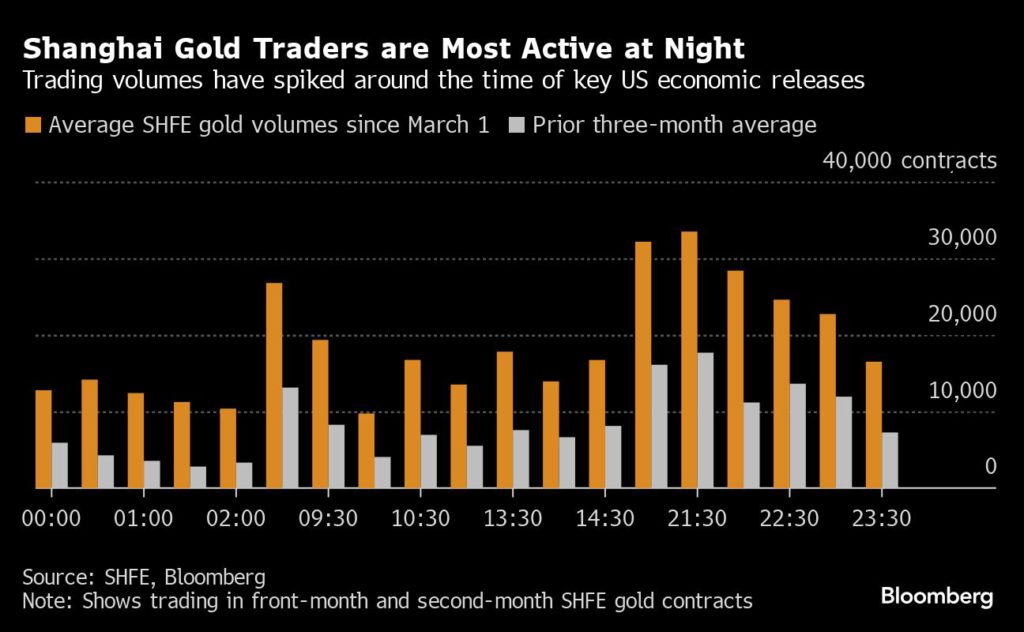
Gold’s record-setting rally this year has puzzled market watchers as bullion has roared higher despite headwinds that should have held it back. With prices sagging this week, the explanation may lie in China.
After weeks of debate about whether a mystery buyer was stoking the rally, several prominent figures in the global gold market are coming to the conclusion that the major new driving force is a legion of fleet-footed retail investors on the Shanghai Futures Exchange.
In a matter of weeks, the SHFE has gone from a sedate futures venue to a nexus of the global gold market. While rival centers such as London and New York have also seen activity rise, the fact that SHFE volumes have spiked from a low base offers a compelling sign that a newly arrived cohort of Chinese investors has helped drive prices sharply higher.

Gold has soared this year, topping $2,000 an ounce from early March in the face of major pressures that, in ordinary times, would have capped gains. Driven by fading expectations for a pivot to lower interest rates from the Federal Reserve, these included higher Treasury yields and a rallying US dollar. On top of that, there was a virtual buyers’ strike in India, the second-largest consumer, disinterest from western funds, and net sales by exchange-traded funds. Yet SHFE volumes started to spike, and prices powered higher.
“The only thing that drives it in a Bitcoin-esque kind of way is massive speculative plays,” according to Ross Norman, a former trader at Credit Suisse Group AG and Rothschilds & Sons., who now helms the Metals Daily journal.
Given elevated rates and the dollar’s strength, that’s unlikely to have come from hot-money in the US, so the most likely buyers would be highly leveraged Chinese investors, he said.
Gold has a longstanding history in China as a savings tool, and the country is the top consumer and leading producer. That traditional interest has been given a new lease of life by turmoil in the local property and stock markets, with imports surging in 2022 and 2023 despite being tightly controlled.
For months, consumers and institutional investors in China have been snapping up physical bullion, while the People’s Bank of China has been on a 17-month buying spree. Those two forces, which helped buoy international prices, have now been augmented by surging speculative demand.
Numbers back up the theory. Trading on the SHFE has exploded, with average daily volume almost tripling in April compared with the preceding 12 months. It peaked at about 1,200 tons on April 15, the highest since 2019, before prices started to sag this week.
“It’s another sign of emerging markets, and particularly Chinese traders, wresting price discovery away from Western markets,” said John Reade, chief market strategist at the World Gold Council. “We know from other commodity markets, that from time-to-time, Shanghai traders become the most dominant players. That’s never really been the case in gold, but I think now that this might have changed.”
For long-haul gold bulls, that could be a worry if gains prove brittle. State media recently urged caution in chasing the rally, while the SHFE raised margin requirements to snuff out excessive risk-taking.
It’s notable that while SHFE volumes have soared, the number of outstanding contracts has hardly moved. That indicates participants day-trading, not taking a long-term view. Bullion fell 2.7% on Monday and losses deepened Tuesday, in a move that Reade attributed to profit-taking by short-term investors on the exchange.
“It’s a bit of a feature of onshore Chinese markets, albeit a relatively extreme example,” said Marcus Garvey, head of commodity strategy at Macquarie Group Ltd. There’s “much more short-term speculative turnover,” he said.
Not everyone thinks Chinese investors are the major driver behind gold’s ascent. “It’s not just mom-and-pop traders and it’s not just China,” said Jeff Christian, managing director at CPM Group. “It’s really a broad-based thing. There isn’t all that much difference now in the trading behavior of large institutions compared to mom-and-pop people.”
Gold may be in favor as higher-for-longer US interest rates to tame inflation may tip the economy into recession, according to Christian. “They’re all becoming convinced that interest rates aren’t going to fall too soon,” he said. “That could be negative for other assets more than it would be for gold.”
Samson Li, a Hong Kong-based analyst at Commodity Discovery Fund, sees a more nuanced picture. Rather than being a direct driver of prices, the frenzied demand in China has encouraged western speculators to ramp up bets on gains in New York, he said.
The debate about how long Chinese investors will stick around is tied to the question of what brought them to SHFE in the first place. Institutional and retail traders on SHFE may be buying gold to bet on short-term fluctuations in the yuan. This year, the exchange’s night session has been the most active, just when a raft of hot US economic data has driven the dollar higher.

Daniel Ghali, a senior commodity strategist at TD Securities, has also been on the hunt to identify gold’s mystery buyer, and he still thinks that the dominant force is likely to be a deep-pocketed buyer in the so-called official sector, which covers state-linked institutions such as central banks and sovereign wealth funds. But he says buying activity there has also been closely correlated with weakness in the yuan, and investors on SHFE may be acting with the same underlying motivations.
“The trading activity on the SHFE, it does point to retail speculation and that could be associated with the currency pressures,” said Ghali. “It’s not just an issue for the central banks out there – it’s an issue for everyday participants who see that their currency is depreciating and want to hedge against it.”
(By Mark Burton, Sybilla Gross and Yvonne Yue Li)
Comments